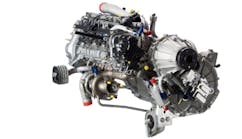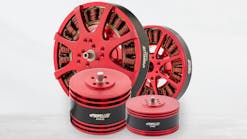The world of aircraft parts manufacturing and distribution is regularly evolving, either via technological advancements, customer demands, or in response to world events and other geopolitical factors.
To gain insight into the current trends and challenges facing the industry today, AMT reached out to Darren Spiegel, Vice President & General Manager, AAR Electronics, and Ben Hockenberg, Chief Operating Officer, JSSI.
AMT: What are the most pressing supply chain challenges facing parts distributors and manufacturers?
Spiegel:
Raw materials still remain an issue. There seems to be a perfect storm of record demand in both commercial and military applications and the rebound post-COVID has caught most manufacturers off guard. Distributors continue to help buffer these supply chain issues. Accurately forecasting OEM customer demand in an evolving environment is challenging. A distributor aggregating demand for multiple customers eases the planning challenge.
Hockenberg:
Labor shortages are at the root of many of the ongoing supply chain challenges. The industry continues to see a gap in technical expertise and resources. This existed pre-COVID but was compounded when skilled workers left the industry during the pandemic years. Technical expertise, talent and knowledge is hard to find and replace. The result is long turnaround times in shops and new parts that fail to meet specific quality standards and inspection criteria, which can increase lead times even further.
Legacy platforms have become challenging to support from a parts perspective. Aircraft that may have previously been retired much earlier continue to fly, as the backlog on new deliveries and boost in demand for business aviation has extended their life in operation. Supply chain challenges continue to impact repair turnaround times for these aircraft, especially for internal engine parts and sub-components, wheels, landing gear and windshields.
Component repair has presented issues. We see certain parts get stuck in repair shops as turn times are affected by backorders on downstream piece parts.
AMT: How has the aircraft parts distribution and manufacturing landscape evolved in recent years?
Spiegel:
We have found OEM customers as well as their contract manufacturers continue to turn to distribution to support their supply chains. They see value in having just-in-time stock, and component manufacturers prefer the predictability of orders from distribution partners. Distribution also serves a role to aid in finding opportunities for design registrations working with engineering teams to develop parts specific to the customer’s need. Traditionally, OEM customers bought stock directly from the component OEMs. We are seeing an increased need for the stock planning and availability a distributor relationship brings.
Hockenberg:
In the aftermarket, higher aircraft utilization across the global fleet has exacerbated supply chain challenges. To solve this, the industry should improve collaboration and embrace alternative supply channels. For example, many OEMs have adopted a dual sourcing approach as the need for options became evident when many smaller parts manufacturers - which they relied on - went out of business during COVID.
We have seen procurement processes necessarily evolve to meet larger fleets which are a result of industry consolidation. As fleets grow larger and utilization is high, procurement support has started to evolve to better meet expectations for quick and seamless service; digitization is an important enabler. For example, JSSI recently launched PartsHub: a new e-commerce store for parts. The platform presents inventory transparency and all the critical information needed to compare options, tags and pricing directly online for seamless checkout. This ‘Amazon experience’ for parts helps procurement and maintenance teams automate and scale to enable them to minimize downtime across a larger fleet.
AMT: What significant changes do you anticipate in the industry by 2024?
Hockenberg:
Supply chain trends continue to play out - but I believe we are better prepared as an industry to tackle these challenges. Through data and analysis, we have become more proactive to get ahead of maintenance events and parts needs. Collaboratively, OEMs, operators and service providers have all come together to fill gaps in the supply chain, and embrace the use of serviceable material (USM) as a way to fill gaps when new OEM parts are either not accessible or cost effective.
AMT: How has technology impacted the manufacturing and distribution of aircraft parts?
Hockenberg:
Recent advancements in technology have started to revolutionize parts procurement and maintenance event management. Historically, buyers relied heavily on manual processes and relationships to source quality parts. However, supply chain challenges coupled with a new generation of maintenance workers has caused an increased demand for digital solutions that simplify time-consuming tasks and streamline processes.
Procurement teams today are often stretched thin; automation and actionable data can significantly help save time, reduce friction and get aircraft back to service faster. As such, JSSI continues to invest in new technology: from acquiring and perfecting leading-edge maintenance and inventory tracking software (Traxxall and SierraTrax), to building a parts ordering platform that reinvents the procurement process (PartsHub). These advanced data-powered platforms are designed to help drive down time and cost, while ensuring regulatory compliance, safety, and operational control.
We see the trend around predictive analytics continuing, as new technologies and tools develop to help operators and maintenance teams leverage real-time insights, enabling better planning and more informed decisions. At JSSI, we follow the evolution of new technologies such as AI closely; invest in our client-facing data platforms; and double-down on making our internal operating systems most efficient to best serve and be proactive on behalf of our customers.
AMT: Are there any emerging technologies that will significantly alter the industry in the next few years?
Spiegel:
The electrification of aircraft continues to drive product development. Traditional airline and military aircraft designs are displacing pneumatic and hydraulic systems with electronic components. On top of this change, the expansion of UAV builds along with the eventual eVTOL market is fostering a new design philosophy where OEMs and distributors are involved in the design stage with parts being custom-tailored for the specific platform.
AMT: Have customer expectations changed in recent years, and how are you adapting?
Spiegel:
Customers are considering the supply chain challenges when planning purchases. This means we are seeing earlier scheduled orders to support the customer over time.
AMT: How do global market trends affect your parts manufacturing and distribution business strategy?
Spiegel:
We believe U.S.-based component OEMs might be underserved by distributors in Asia. We have had multiple requests for support in Asia, using AAR´s current footprint to broaden their reach.
AMT: From your perspective, how should MROs/repair stations approach the cost-benefit analysis of OEM vs. aftermarket parts?
Hockenberg:
There is a perception in the industry that new OEM parts better help preserve the value of an aircraft when it goes into service. Enhancing residual value is especially important to owners of younger and newer aircraft, and aftermarket options may even be limited for the latest platforms.
However, in the current supply chain environment and specifically for legacy platforms, used serviceable material (USM) is sometimes the only option to solve a maintenance requirement or AOG situation quickly. There has been a sharp shift in the industry to embrace other options and utilize ‘aftermarket’ parts.
Part availability is often the stronger force in today’s market, and USM has become increasingly popular and can help drive down both cost and turn time. Ultimately, it’s up to each operator how they want to approach sourcing parts, depending on their specific requirements, preferences, and price sensitivity.
AMT: When selecting parts suppliers or manufacturers, what advice would you give to MROs/repair stations?
Hockenberg:
Trust is always a big factor when choosing a service provider; operators, procurement teams, and manufacturers need a partner who can deliver a quality part within the timeframe communicated. Additionally, transparency around tags and certifications - and operational rigor to ensure delivery expectations and quality standards are met - continue to be important considerations.
AMT: Can you share examples of innovation or improvements in your manufacturing/distribution processes?
Spiegel:
We are enhancing digital tools for forecasting, planning and market intelligence. The more information AAR can feed back to our OEM partners to allow them to be more efficient and outgrow their market helps not only them, but their end customers.
AMT: What final thoughts or advice do you have for our readers?
Spiegel:
If you are an OEM that does not currently use distribution services, I would recommend taking a second look at the value that can be provided. In most cases these services pay for themselves with on-time delivery, customer service, and market growth through product development or design registration. As an OEM customer, or end user, if you are frustrated with current support/deliveries consider a distribution partner to aggregate your demand, and pre-buy stock based on your forecast.









